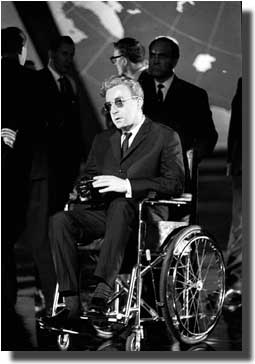
Not with a Whimper:
Visions of Mass Destruction in Fiction and Film
Richard Pells
![]()
|
It has so far proven very "difficult for novelists or filmmakers to portray the mentality of the stateless terrorist, the messianic fanatic who seeks to murder people indiscriminately, for no obvious purpose except to pile up the bodies," says Richard Pells, professor of history at the University of Texas at Austin. Particularly during the Cold War, Pell says, many novelists and filmmakers worked "with utmost seriousness" to "make comprehensible our universal peril."
The author of three books, Pells is currently at work on From Modernism to the Movies: The Globalization of American Culture in the Twentieth Century.
"This is the way the world ends
This is the way the world ends
This is the way the world ends
Not with a bang but a whimper."
—T.S. Eliot, The Hollow Men
One of the most famous paintings of the 20th century is Pablo Picasso's Guernica. There is a good, if frightening, reason for its fame. A commemoration of the bombing of a Basque town by German and Italian planes during the Spanish Civil War, the painting portrays the agony and terror of people and animals being obliterated by modern weapons of mass destruction. Guernica is also a premonition of the even more savage attacks on civilian populations during World War II, as well as of a world filled with nuclear and biological weapons —a world in which we all now live.
Since the end of World War II, we have often depended on artists to make comprehensible our universal peril, to measure our chances for survival in an age when innocent people can be instantly gassed, asphyxiated with deadly toxins, or incinerated. And many novelists and filmmakers have done so with the utmost seriousness, particularly during the Cold War.
The prospect of nuclear war between the Soviet Union and the United States yielded at least two best-selling novels in the 1950s and early 1960s. Nevil Shute's On the Beach (published in 1957, and made into a movie with an all-star cast in 1959, then remade as a mini-series for U.S. television in 2000) described the effects of radiation as the planet slowly died in the aftermath of a nuclear exchange between the superpowers. Eugene Burdick's Fail Safe was published in 1962, the same year as the Cuban missile crisis, the one moment in the Cold War when the United States and the Soviet Union might have actually used their nuclear arsenals against each other. The movie version of Fail Safe, in 1964, starred Henry Fonda as an American president confronted with an accidental attack on the Soviet Union; he decides to drop an atomic bomb on New York in compensation for the annihilation of Moscow.
Yet it is impossible for people to live in perpetual fear. Or to imagine the insanity of a nuclear war without a dose of dark humor. In 1958, the great satirical song-writer, Tom Lehrer, composed an ode to the end of the world, titled "We Will All Go Together When We Go." A sample verse: "We will all burn together when we burn/There'll be no need to stand and wait your turn/When it's time for the fall-out and Saint Peter calls us all out/We'll just drop our agendas and adjourn."
|
But no novel or film during the Cold War captured the lunacy of our situation more memorably than Stanley Kubrick's Dr. Strangelove (1964). Its subtitle was How I Learned to Stop Worrying and Love the Bomb. This time nuclear war, "toe to toe with the Russkies," is no accident; it's launched by a crazed American General, Jack D. Ripper, worried about a "Commie plot" to put fluoride in the drinking water and cause the loss of his bodily essences. With Peter Sellers in three roles—as a British officer (the lone voice of reason in the movie) detailed to General Ripper and frantically trying to figure out the code that will recall the American bombers, the U.S. president (far more muddled than Henry Fonda), and an ex-Nazi scientist who understands not only the "Doomsday" machine that will blow up the world but the postwar mine shafts that will house the survivors—Dr. Strangelove ends with mushroom clouds and images of oblivion more mordant, and more chilling, than any other work of art or entertainment in the Cold War years.
Still, the Cold War—however grim—was familiar and oddly comforting. It was, after all, a contest between two nation-states, each with a lot to lose. Policymakers on both sides understood the rules of the game, and the limits beyond which they couldn't go. General Ripper may have gone "a little funny in the head," but most of the Cold War protagonists—in art and reality—weren't psychopaths. They were, like Henry Fonda, cool customers, rational custodians of terrifying weapons, trying never to miscalculate. Or, as Peter Sellers' American President tells the Soviet Premier: "We're in this together, Dmitri. Don't say you're sorrier than I am; I'm just as sorry as you."
This sense of the Cold War as a competition between adversaries, rather than as a hunger for Armageddon, explains why so many of the era's spy novels are really psychological thrillers, with agents maneuvering for tiny advantages against their equals in an interminable chess match where ultimate "victory" is not achievable. The focus here is on the tradecraft, duplicity, and cleverness of the spy—as in the novels of John le Carr? whose British agent George Smiley plays intricate intelligence games with his Soviet KGB counterpart, Karla. Both behave with restraint and mutual respect, befitting professional spies with peculiar codes of honor in the midst of the Cold War, but who can never come in from the cold.
The Cold War, and the dangers of a nuclear conflagration, were at least imaginable in fiction and films. Perhaps this was because nuclear weapons were always seen as the property of and controllable by a state. States are not suicidal—not even "rogue" states like Iran or North Korea. So their governments are normally susceptible to negotiation or pressure. The conflicts between members of the nuclear "club," we assume, can somehow be managed by experts in throw-weights and multiple warheads.
It has, however, been much more difficult for novelists or filmmakers to portray the mentality of the stateless terrorist, the messianic fanatic who seeks to murder people indiscriminately, for no obvious purpose except to pile up the bodies. And who is willing to use any means—from car bombs to hijacked planes to nuclear and biological weapons—to accomplish the mission.
From the 1960s on, there have been efforts to penetrate the terrorist's mind. The James Bond films usually featured a megalomaniac bent on obtaining a weapon of mass destruction with which he could take command of the planet. Yet the Bond movies, with their spectacular explosions amid the vodka martinis, exuded amusement and charm rather than horror. In 1983, Le Carr? taking a vacation from the intrigues of Smiley and Karla, sought to decipher the psychology of Palestinian terrorists in The Little Drummer Girl. But the novel (and the 1984 film on which it was based) was more about the cerebral struggle between Israeli intelligence agents and their Palestinian foes than about mass murder.
More recently, films like The Rock and The Devil's Own portray the quest for weapons in the service of either a political movement or personal grievance. In the case of The Rock, Ed Harris is the leader of a gang of ex-military thugs who've taken over Alcatraz Island in the middle of San Francisco Bay, once a federal prison site, and are threatening to unleash chemical weapons on San Francisco. But Harris and his band are out for money and revenge; they don't yearn to ascend to heaven through an act of martyrdom. Meanwhile, in The Devil's Own, Brad Pitt plays an Irish Republican Army operative who comes to the U.S. to purchase guns and rockets, not nuclear or biological weapons. And, like the Palestinians in The Little Drummer Girl, he's a killer because he wants to create a state. His targets are deliberate (the British and Northern Ireland Protestants); he's not thirsting to massacre everyone in sight. In yet another film, 1997's The Peacemaker, starring George Clooney and Nicole Kidman, Russian nuclear warheads are stolen, and a weaponized backpack eventually ends up in the hands of a Bosnian Serb terrorist determined to destroy Manhattan. His motivation is also revenge and money.
Above all, these terrorists are not in love with death; they concoct strategies that, however implausible, will allow them to escape and continue to fight for the "cause." What novelists and filmmakers have not yet fully envisioned is terror for its own sake—without rules, codes, or limits. Nor have they imagined a state of mind in which suicide is the road to sainthood. And so all of us, not just in the West, are in a frightening void, without the "comforts" of the Cold War or the art forms it inspired.
Clearly, the international community needs to strengthen the treaties and protocols that will control the proliferation of nuclear and biological weapons developed by countries and by non-state terrorists, and to continue to deal with the menace of terrorism through a variety of legal means. But we also need, in the 21st century, another Pablo Picasso or a Stanley Kubrick to warn us of what our fate will be if we don't superintend the horrific weapons we have created. Otherwise, as Picasso and Kubrick both knew, our world may end with a bang, not with a whimper.
![]()
The opinions expressed in this article do not necessarily reflect the views or policies of the U.S. government.
![]()

